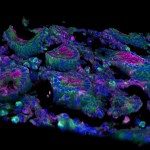Link to Pubmed [PMID] – 21739438
Link to DOI – 10.1002/jmv.22132
J Med Virol 2011 Sep; 83(9): 1499-507
The gut-associated lymphoid tissue represents the largest reservoir of HIV-1. Improving knowledge of this reservoir by studying the diversity of viral population is a key step towards understanding the pathogenesis and dynamics of HIV. Obtaining samples is difficult and little information is available on gut viral quasispecies during the course of infection in humans. The aim of this study was to characterize rectal viral strains and their diversity and to investigate the relationships between the rectal tissue reservoir and viral variants in the blood. Phylogenetic analyses were performed on the env sequences for rectal HIV DNA, blood HIV DNA, and HIV RNA clones, with maximum-likelihood and neighbor-joining methods on seven patients. Genetic diversity was assessed. Higher diversity of HIV DNA clones was noted in the rectum compared to blood in four out of five patients without HAART. Viral diversity was present in the rectum from time of the primary infection. Similar degrees of diversity were observed in the rectum and blood during HAART. Rectal and blood HIV variants were interspersed partially or totally in the seven patients. A certain number of rectal HIV DNA clones were clustered together in six patients. These results suggest that variants in the rectum were more heterogeneous than variants in the blood from patients without HAART, probably because the activated milieu of gut-associated lymphoid tissue may provide an improved environment for viral replication, and indicate exchange of viral populations between blood and rectal tissues, reflecting the dynamics of HIV during course of infection.

